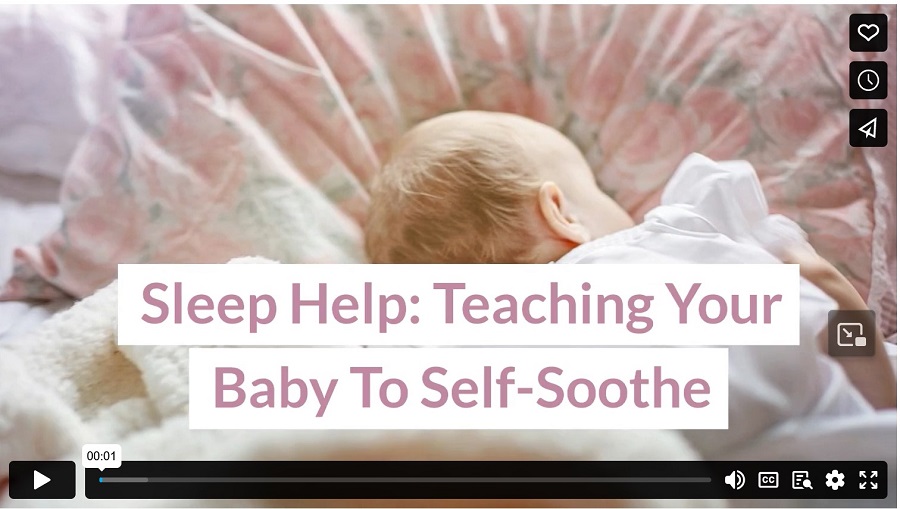Self-settling or soothing is a battle that every parent faces. Sleep is natural, so you shouldn’t have to teach your baby to sleep, right? In theory, this is true, but certain habits can sabotage self-soothing later.
The good news is your little one can start learning to self-soothe as early as four months old, and it doesn’t have to be some abrupt change that leads to tears from everyone involved. While there’s no single cookie-cutter solution that will help every baby self-soothe, these steps will help guide your baby to sleep through the night independently.
Establish A Bedtime Routine
You don’t need to do some elaborate bedtime routine every night, but even babies thrive off structure and patterns. Something as simple as reading a book or singing a song before setting them down in their crib helps cue their brain to prepare for sleep.
Consistency helps them know what to expect next, so they know how to respond to the situation and relax into the ritual. If you haven’t already discovered the magic of bathtime as part of your nighttime routine, read more about it and other bedtime routine tips here.
Ensure They Have An Optimum Sleep Environment
Sleep in a busy, loud, bright environment can happen, but it won’t be the most restful and restorative sleep you’ve ever had. The same goes for your baby. While it’s great if they can sleep through the bright glare of the morning sun, they will get optimum sleep in a dark, cool, and quiet room. They are more likely to stay asleep in the first place but also self-soothe back to sleep without the irritations of noises, sweat, chills, or lights.
Their room should be dim and free from electronic glares, if not completely dark. If you need a night light to help navigate their space, using a red light is the least disruptive to their sleep.
Use white noise to block out surrounding sounds. If you use a noise maker, make sure to take it with you when you travel. Your child will be much more likely to sleep in a new environment if the sounds around them stay consistent.
Set Regular Sleep Times
Like the bedtime routine, having a set window for sleep helps teach your little one’s body and brain that it’s sleep time.
You have encountered this when you travel to a different time zone. Even though it might be the middle of the day, if it’s bedtime where you live, you will start yawning and getting tired.
Consistency matters. Your baby is more likely to sleep well if they’re going to sleep at the same bedtimes and naptimes each day.
Avoid Feeding To Sleep
If your little one falls asleep while drinking either from a bottle or breast, they cannot learn how to self-soothe. If this habitually happens, consider moving the feed to an earlier part of your bedtime routine or starting the entire ritual earlier to help prevent this from happening.
Your child will still get enough food to fall asleep satiated, but they can begin learning vital self-soothing skills. They may resist this change initially, so you should offer verbal assurance or gentle touch to ease them through the transition of less body contact and liquids to help them fall asleep.
Additionally, if you offer a feeding every time your baby wakes up overnight, they will depend on it to fall back to sleep whether they are hungry or not. Check with your pediatrician to see when it’s clear to wean overnight feedings. Once safe to do so, tackle one feeding at a time. Reduce by an ounce from the bottle or about five minutes from the feeding length each night.
Continue reducing with this increment until you’re down to an ounce or five-minute feed, then stop it altogether. Typically, your infant will have adjusted and no longer wake up at their usual feeding time. If they wake that first night at their standard feeding time, offer them the same support you would when you put them to sleep at bedtime.
After you’ve stopped nighttime feeds gradually, your child will naturally start eating more during the day. If they are well-fed during the day, you can be sure they are not hungry when they wake overnight unless they’re sick or something else prevents them from getting their calories in during the day. This helps you troubleshoot what else is causing overnight wakings, ensuring a faster path to independent sleep.
Introduce A Security Object When Safe
You should always follow the ABCs of safe sleep: put your baby to sleep Alone, on their Back, in their Crib. However, there is a certain age when sudden infant death syndrome (SIDS) risk drops off, and you can start to use pillows, blankets, and cuddly toys in your little one’s bed.
Your pediatrician can guide you with the recommendations of when it’s safe to introduce a breathable comfort item into your baby’s crib. This can help support and anchor them while they learn to self-soothe back to sleep. If they’re too young for a lovey, you can use a pacifier to help with self-soothing, as it also lowers SIDS risks.
You can begin incorporating most of these steps for naptimes and bedtime before reaching the four-month point, ensuring your little one will be a pro sleeper from day one. If you have an older baby and are starting some gentle sleep tips to encourage self-soothing, you should first ensure you’ve met your baby’s needs. Make sure they’re getting enough to eat during the day, aren’t overtired or overstimulated, and are going to bed with a dry diaper.
Trust that your baby will sleep, let them know it’s time for sleep, set them down, and see what happens. Stay close to provide reassurance, especially if this is entirely new to them or you’ve just stopped feeding to sleep. By taking these steps, you can train your infant to sleep through the night independently.
Video



